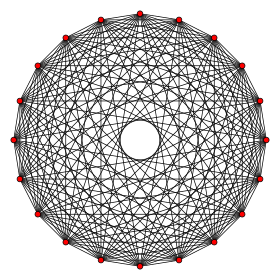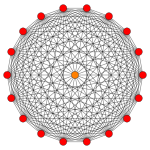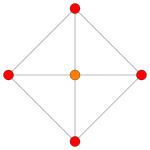10-orthoplex
| 10-orthoplex Decacross | |
|---|---|
 Orthogonal projection inside Petrie polygon | |
| Type | Regular 10-polytope |
| Family | Orthoplex |
| Schläfli symbol | {38,4} {37,31,1} |
| Coxeter-Dynkin diagrams | |
| 9-faces | 1024 {38} |
| 8-faces | 5120 {37} |
| 7-faces | 11520 {36} |
| 6-faces | 15360 {35} |
| 5-faces | 13440 {34} |
| 4-faces | 8064 {33} |
| Cells | 3360 {3,3} |
| Faces | 960 {3} |
| Edges | 180 |
| Vertices | 20 |
| Vertex figure | 9-orthoplex |
| Petrie polygon | Icosagon |
| Coxeter groups | C10, [38,4] D10, [37,1,1] |
| Dual | 10-cube |
| Properties | Convex |
In geometry, a 10-orthoplex or 10-cross polytope, is a regular 10-polytope with 20 vertices, 180 edges, 960 triangle faces, 3360 octahedron cells, 8064 5-cells 4-faces, 13440 5-faces, 15360 6-faces, 11520 7-faces, 5120 8-faces, and 1024 9-faces.
It has two constructed forms, the first being regular with Schläfli symbol {38,4}, and the second with alternately labeled (checker-boarded) facets, with Schläfli symbol {37,31,1} or Coxeter symbol 711.
It is one of an infinite family of polytopes, called cross-polytopes or orthoplexes. The dual polytope is the 10-hypercube or 10-cube.
Alternate names
- Decacross is derived from combining the family name cross polytope with deca for ten (dimensions) in Greek
- Chilliaicositetraxennon as a 1024-facetted 10-polytope (polyxennon).
Construction
There are two Coxeter groups associated with the 10-orthoplex, one regular, dual of the 10-cube with the C10 or [4,38] symmetry group, and a lower symmetry with two copies of 9-simplex facets, alternating, with the D10 or [37,1,1] symmetry group.
Cartesian coordinates
Cartesian coordinates for the vertices of a 10-orthoplex, centred at the origin are
- (±1,0,0,0,0,0,0,0,0,0), (0,±1,0,0,0,0,0,0,0,0), (0,0,±1,0,0,0,0,0,0,0), (0,0,0,±1,0,0,0,0,0,0), (0,0,0,0,±1,0,0,0,0,0), (0,0,0,0,0,±1,0,0,0,0), (0,0,0,0,0,0,±1,0,0,0), (0,0,0,0,0,0,0,±1,0,0), (0,0,0,0,0,0,0,0,±1,0), (0,0,0,0,0,0,0,0,0,±1)
Every vertex pair is connected by an edge, except opposites.
Images
| B10 | B9 | B8 |
|---|---|---|

|

|

|
| [20] | [18] | [16] |
| B7 | B6 | B5 |

|

|

|
| [14] | [12] | [10] |
| B4 | B3 | B2 |

|

|

|
| [8] | [6] | [4] |
| A9 | A5 | |
| — | — | |
| [10] | [6] | |
| A7 | A3 | |
| — | — | |
| [8] | [4] | |
References
- H.S.M. Coxeter:
- H.S.M. Coxeter, Regular Polytopes, 3rd Edition, Dover New York, 1973
- Kaleidoscopes: Selected Writings of H.S.M. Coxeter, edited by F. Arthur Sherk, Peter McMullen, Anthony C. Thompson, Asia Ivic Weiss, Wiley-Interscience Publication, 1995, ISBN 978-0-471-01003-6 [1]
- (Paper 22) H.S.M. Coxeter, Regular and Semi Regular Polytopes I, [Math. Zeit. 46 (1940) 380-407, MR 2,10]
- (Paper 23) H.S.M. Coxeter, Regular and Semi-Regular Polytopes II, [Math. Zeit. 188 (1985) 559-591]
- (Paper 24) H.S.M. Coxeter, Regular and Semi-Regular Polytopes III, [Math. Zeit. 200 (1988) 3-45]
- Norman Johnson Uniform Polytopes, Manuscript (1991)
- N.W. Johnson: The Theory of Uniform Polytopes and Honeycombs, Ph.D. (1966)
- Klitzing, Richard. "10D uniform polytopes (polyxenna) x3o3o3o3o3o3o3o3o4o - ka".
External links
- Olshevsky, George. "Cross polytope". Glossary for Hyperspace. Archived from the original on 4 February 2007.
- Polytopes of Various Dimensions
- Multi-dimensional Glossary
